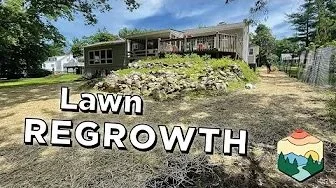Maintaining a lush, green lawn can be a challenge under the best conditions, but when you’re dealing with a shaded area, it becomes even more difficult. At Auburn Sky Landscaping, we recently took on a project to help homeowners struggling with just that—transforming a patchy, weed-infested space into a beautiful, thriving lawn.
The Challenges of Growing Grass in the Shade
The homeowners had faced difficulties establishing a lawn due to several factors:
Limited Sunlight – Grass needs ample sunlight to thrive, and shaded areas often struggle to sustain healthy growth.
Poor Topsoil – Without nutrient-rich topsoil, new grass struggles to take root.
Invasive Species – The property was overrun with Japanese silt grass, a persistent weed that thrives in shady environments.
Sloped Terrain – The yard had a downhill grade, leading to erosion and topsoil runoff.
Our Lawn Renovation Approach
To give the homeowners the best chance at a lush, green lawn, we focused on several key strategies:
1. Selecting the Right Grass Seed
Shade-tolerant grass varieties are essential for success. We chose a high-quality premium shade mix to ensure the grass could thrive with minimal sunlight.
2. Improving the Soil Quality
The existing soil lacked the nutrients necessary for healthy growth. We brought in 36 yards of topsoil to enrich the ground and provide a strong foundation for the new lawn.
3. Preventing Erosion
Given the slope of the yard, soil erosion was a major concern. To combat this, we installed erosion control mats to hold the soil in place and prevent runoff.
4. Proper Watering and Maintenance
Overwatering is a common mistake in shaded areas. Too much moisture can lead to fungal growth and poor grass health. We advised the homeowners to water carefully, ensuring that the soil stayed moist but not saturated. As the seasons changed, we recommended reducing watering frequency going into the fall to prevent excessive moisture retention.
5. Using Straw for Quick Establishment
Straw is an excellent insulator, helping to retain heat and promote germination. We used a generous layer of straw to encourage rapid grass growth while protecting the soil from erosion.
The Transformation
Two months after the initial renovation, we returned to check on the progress—and the results were incredible! The once patchy, weed-ridden yard had transformed into a lush, green lawn. The homeowners had done a fantastic job maintaining the area, following our guidance on watering and care. The erosion control measures held up well, and the invasive Japanese silt grass had been replaced by thick, healthy grass.
Final Thoughts
Growing grass in a shaded area is no easy feat, but with the right strategy, it can be done. The key is to focus on:
Choosing a shade-tolerant grass variety
Improving soil quality
Preventing erosion
Following proper watering and maintenance routines
By implementing these steps, homeowners can turn even the most challenging lawn into a green, vibrant space.
If you're struggling with a shady lawn, Auburn Sky Landscaping is here to help. Reach out to us, and let’s turn your struggling yard into a thriving oasis!

